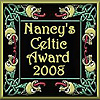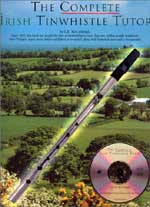| |

Traditions, folklore, history and more. If it's Irish, it's here. Or will be!
"People will not look forward to posterity who never look backward to their ancestors."
-Edmund Burke




Quotes
Library: Books, Movies, Music
Prints & Photos
Poetry
Jokes


Shops Ireland
Bunús na Gaeilge
(Basic Irish)
Circle of Prayer
Blessings
Did You Know?
Himself/Herself
Write to Us
Readers Write..
Links/Link to Us
Advertise with us
Awards & Testimonials
Submissions Guide


|
|
|
 Symbols & Emblems of Ireland - The Penny or Tin Whistle Symbols & Emblems of Ireland - The Penny or Tin Whistle
by Bridget Haggerty
No one seems to be quite sure how the term penny whistle originated. It is generally thought that Robert Clarke originally sold his tinwhistles for a penny, or the term was used because people used to throw pennies to whistle players in the streets as they played.
What we do know is that in 1843, Robert Clarke, a poor farm laborer, left his employer after having been unjustly accused of dishonesty. He was a talented amateur musician and played a wooden whistle. He developed the idea of copying his whistle but used tinplate to do so. He made the block in the mouthpiece out of wood which he cut into shape using a homemade saw. This saw started life as one of his wife's corset stays! Then he decided to mass produce his new style of whistle.
He loaded the necessary materials and his simple tools onto a handbarrow and, together with his son, walked all the way from Suffolk to Manchester. On the way he would set up his workshop barrow in market places, showing how the whistles were made and selling them. He would also play for the entertainment of the crowds that gathered round. His most popular piece was "Danny Boy". It is said that the whole busy market would stop and listen when he played this piece.
Whether it's made of wood, clay, cane, metal, or other material, the feaddan or whistle is as synonymous with the distinctive sound of Irish music as the fiddle, harp or bodhran and there is evidence of whistle players in early literature and on ancient high crosses.
 According to L. E. McCullough in his best-selling book "The Complete Irish Tinwhistle Tutor", the instrument has a lengthy pedigree in the historical annals of Irish music. According to L. E. McCullough in his best-selling book "The Complete Irish Tinwhistle Tutor", the instrument has a lengthy pedigree in the historical annals of Irish music.
In his Historical Notes, he writes: "While the oldest surviving specimens are the 12th-century bone whistles recently unearthed at the High Street excavations in the old Norman quarter of Dublin, various types of whistle flutes that were the progenitors of the modern tinwhistle are frequently mentioned in the ancient tales and in the laws governing ancient Irish society. There is the tale in which Ailen, a chief of the fairy tribe Tuatha de Danann, uses the feadan to cast a spell of sleep over the inhabitants of the High King's palace at Tara, so that he can carry out his annual November Eve vengeance.
Players of the feadan are also mentioned in the description of the King of Ireland's court found in the Brehon Laws dating from the 3rd century A.D. The 12th-century reference in the poem about the pre-Christian Fair of Carman includes cuisleannach (players of the cuisle, or pipe) among the entertainers, despite an obvious aesthetic disapproval on the poet's part.
A more complimentary view of the cuisle is expressed by the 12th-century compiler of the Acallam na Senorach in the comparison of its timbre and the sound of a maiden's speech.
One of the most interesting references occurs in an ancient poem found in the Teach Miodhchuarta where the seating plan of the royal feasts at Tara is given; cuisleannach are placed in the same division as smiths, shield-makers, jugglers, trumpeters, shoemakers, and fishermen, to name a few of their social compatriots. It might be of some interest to note that the cuisleannach received the pig's thigh as their allotted portion.
Through the efforts of 19th-century specialists in ancient Irish society, it has been possible to obtain some insight into the nature of the various "musical pipes" that flourished during this time. Both the feadan (also called feadog) and cuisle (also called cuiseach) refer to a "pipe, tube,artery,vein" and were made by hollowing out the stalks of plants such as elder, cane, and other wild grasses and reeds (an additional meaning of feadan is "a hollowed stick"). Uileann pipemaker Patrick Hennelly of Chicago recalled that as a young lad in Mayo, he often made musical instruments from ripe oat straws simply by pushing out the pith and then fashioning the lip and fingerholes with a penknife, and, indeed, the basic structural principles of such instruments must have been discovered fairly early and by many people. Later, as the technology advanced, more permanent materials such as wood and bone came into use, and various fipples, tongues, and reeds were devised for sounding the instruments.
Stone high-crosses of the 9th, lOth, and 11th centuries reveal these pipes to have been straight or sometimes slightly curved up at the bottom. They possessed narrow conical bores that widened toward the bottom and are estimated to have been between 14 and 24 inches long. Currently-manufactured tinwhistles in the key of Bb (actually pitched two whole tones below concert pitch) measure 14 3/4 inches in length, but there is little reliable information about the scales or pitch resources of the feadan or cuisle. Possibly, harmonics or over-blown notes may have been used, as is the case with similar types of simple flutes throughout the world. End-blown pipes representative of the general type found in medieval Britain and Ireland were discovered in Somerset and Monmouthshire, England. Made of deer bone, they each had five front fingerholes; one had two rear thumbholes, while the other pipe had one. One pipe had a range of 11/2 octaves, the other 21/2. These pipes were restored to playable condition, and it was found that each could give diatonic scales (as can the modern tinwhistle) It is not unlikely that a relatively sophisticated music was played on ancient bone pipes of this kind.
Occasionally, these pipes were depicted as being played in twos and threes by the same player; this might have been achieved by holding two or three different pipes in the hands, similar to the ancient Greek aulos and Roman tibia. In ancient times double reeds made of cane were used to sound the pipes. It is possible that the tubes were bound together like the parallel double and triple pipes still found in Eastern and Southern Europe and North Africa. In any case, the possibility exists that harmonies and countermelodies may have been practiced by players of the feadan and cuisle.
There is some difference of opinion concerning the instrument known as the buinne (or bunne). Some scholars believe it was a horn or trumpet used for military and hunting purposes rather than general musical entertainment, while others think it was similar to the feadan and cuisle and was equipped with a single reed in the mouthpiece. What might clinch the argument is that the buinnire were seated at the King's feasts at Tara alongside the players of the corn (trumpet).
The modern tinwhistle belongs to the species of musical instruments called flageolets, of which the recorder is a familiar example. The terms "whistle flutes" or "fipple flutes" are also used to designate flageolets and refer to the method of sound production. The fipple is an apparatus formed by a small plug or block, usually of wood, set into the mouthpiece, or, in some cases, is part of the mouthpiece itself. The fipples in the bone flutes from the Middle Ages were made of clay. A small space or duct is created between the edge of the fipple and the inside wall of the instrument; the player's airstream is directed by this fipple/duct system against a sharp edge or lip that is cut into the tube below the fipple, thereby producing sound. This type of vertically-blown flute became known to Europe around the 11th century, according to musicologists, and exists today in various forms throughout the world. "
In summary, the tin whistle of today is a longer lasting version of the wooden feadan. It gives that distinctive sound to Celtic music, making it recognisable anywhere and the jigs and reels soon have everyone tapping their feet or up on the floor dancing. But it can also sound hauntingly beautiful and it's said that the selkies or seals are extremely fond of its magical melodies - so much so that they will surface and come out of the water to sit on the rocks and listen to it being played.

Questions about Whistle playing? Ask our resident Whistle Player: nicole@lollysmith.com
Resources
Content:
 Historical Notes on the Tinwhistle are reprinted by kind permission of L. E. McCullough and are from his best-selling book The Complete Irish Tinwhistle Tutor Historical Notes on the Tinwhistle are reprinted by kind permission of L. E. McCullough and are from his best-selling book The Complete Irish Tinwhistle Tutor
Mr. McCullough lives in Woodbridge, New Jersey and is a musician, composer and author of several books on the history and performance of Irish traditional music. To learn more, visit:feadaniste
Image
Nicole Smith, daughter of Candy and Owen Smith and an accomplished musician; along with her father and brother, she enjoys playing at irish festivals and fairs. By the way, according to her dad, she hates this photo!
|
|
Fri, Sep 27, 2024
 The Galway Hooker The Galway Hooker
This unique vessel, with its distinctive curved lines and bright red sails, originated in the village of Claddagh. During the 19th century, hookers supported a significant fishing industry and also carried goods, livestock and fuel. Seán Rainey is remembered for building the last of the original boats, the Truelight, for Martin Oliver who was to become the last king of the Claddagh; as king, he was entitled to white sails on his boat. Since the mid seventies, many of the old sailing craft which were on the verge of extinction have been lovingly restored and new ones have been built. During the summer months they can be seen at festivals such a Cruinniú na mBád - the Gathering of the Boats - in Kinvara.
Click for More Culture Corner.
How about an authentic tweed cap woven from pure new wool in county Donegal? The fabric has the colors and character of the Irish countryside; ruggedness to wear well; softness for comfort; and, as they say in Ireland, "Wear it in good health."
Russ has such a cap - two,actually, and he wants more. They shed water like a duck.
Click here for Tweed Cap.
|
According to Colm Sweeney of the Ardara Heritage Centre, "When you buy a yard of Donegal tweed, it's not just a yard, it's a lot of Irish history you're buying."
These children's tweed hats are hand tailored in Donegal of 100% pure new wool tweeds by Hanna Hats. Especially made for kids, it's based on the traditional Irish cap design and has a press fastner peak which can be opened out for a slightly different style.
Read our article The Weavers of Donegal.
Please click here for tweed caps.
|
|
|
|
|




 The Galway Hooker
The Galway Hooker